Functions | |
| def | getPath () |
| Gets the current OS path. More... | |
| def | osStartFile (file) |
| Opens the given file based on the OS. | |
| def | resetGlobalVars () |
| Resets all global variables. | |
| def | open () |
| Opens the current level file. More... | |
| def | save () |
| Saves the current level file. More... | |
| def | play () |
| Plays the current level file. More... | |
| def | levelOrderConfig () |
| Gets the level order config file name. More... | |
| def | changeLevelName () |
| Changes the level name. More... | |
| def | checkNameDups (name) |
| Checks for duplicates of the current name in global objects. More... | |
| def | createGameObject () |
| Creates a new game object. More... | |
| def | openGameObjectScript () |
| Opens the currently selected game object's script file. More... | |
| def | dupGameObject () |
| Duplicates the currently selected game object. More... | |
| def | selectFromCanvas (event) |
| Selects an object based on the cursor position. More... | |
| def | canvasMoveStart (event) |
| Begins moving the canvas based on the mouse position. More... | |
| def | canvasMouseMove (event) |
| Moves the canvas based on the mouse position. More... | |
| def | deleteSelected (key) |
| Deletes the selected game object. More... | |
| def | drawImage (path, obj) |
| Draws the given image to the canvas. More... | |
| def | redrawObjects () |
| Redraws all game objects on the canvas. More... | |
| def | layerUpFunc () |
| Sets the currently selected game object to be layered one layer up. More... | |
| def | layerDownFunc () |
| Sets the currently selected game object to be layered one layer down. More... | |
| def | refreshFields () |
| Refreshes all of the fields. More... | |
| def | refreshList () |
| Refreshes the list of game objects. More... | |
| def | selectInList (event) |
| Selects a game object from the list. More... | |
| def | setName () |
| Sets the name via name field input. More... | |
| def | setX () |
| Sets the x coordinate via x field input. More... | |
| def | setY () |
| Sets the y coordinate via y field input. More... | |
| def | setW () |
| Sets the width via width field input. More... | |
| def | setH () |
| Sets the height via height field input. More... | |
| def | setScriptName () |
| Sets the script name via script field input. More... | |
| def | setClassName () |
| Sets the class name via class field input. More... | |
| def | setSpriteName () |
| Sets the sprite name via sprite field input. More... | |
| def | setPermanentField () |
| Sets the permanent field via permanent field input. More... | |
| def | refreshAll () |
| Refreshes everything. More... | |
Variables | |
| list | globalObjs = [] |
| The global object list. | |
| selected = None | |
| The current selected object. | |
| string | curFileName = "temp.lvl" |
| The current level file name. | |
| list | spriteStore = [] |
| Stores sprites for later. | |
| app = gui("Eternal2DEditor", "1200x900") | |
| Create the application window. | |
| string | canvasTitle = "Scene View" |
| The title of the main canvas. More... | |
| canvas = app.addCanvas(canvasTitle, 0, 0) | |
| Main canvas with images of GameObjects. More... | |
| gain | |
| string | nameField = "Name" |
| The label for the namefield. More... | |
| string | xField = "X" |
| The label for the x coordinate field. More... | |
| string | yField = "Y" |
| The label for the y coordinate field. More... | |
| string | wField = "W" |
| The label for the width field. More... | |
| string | hField = "H" |
| The label for the height field. More... | |
| string | permanentField = "Permanent" |
| The label for the permanent field. More... | |
| string | moduleNameField = "Module Name" |
| The label for the module name field. More... | |
| scriptEntry = app.addLabelEntry(moduleNameField, 4, 0, 2, 1) | |
| string | classNameField = "Class Name" |
| The label for the class name field. More... | |
| string | spriteNameField = "Sprite Name" |
| The label for the sprite name field. More... | |
| string | layerUp = "Move Up" |
| The label for the layer up name field. More... | |
| string | layerDown = "Move Down" |
| The label for the layer down name field. More... | |
| string | listBox = "Scene Hierarchy" |
| The label for the scene hierarchy. | |
| lb = app.addListBox(listBox, [], 1, 0) | |
| Side list with all objects. | |
Detailed Description
Runs the python editor GUI interface. All python code relevant to the editor is found here.
Function Documentation
◆ canvasMouseMove()
| def eternal2Deditor.canvasMouseMove | ( | event | ) |
Moves the canvas based on the mouse position.
◆ canvasMoveStart()
| def eternal2Deditor.canvasMoveStart | ( | event | ) |
Begins moving the canvas based on the mouse position.

◆ changeLevelName()
| def eternal2Deditor.changeLevelName | ( | ) |
Changes the level name.
◆ checkNameDups()
| def eternal2Deditor.checkNameDups | ( | name | ) |
Checks for duplicates of the current name in global objects.
Will append -dup if there is a duplicate.

◆ createGameObject()
| def eternal2Deditor.createGameObject | ( | ) |
Creates a new game object.

◆ deleteSelected()
| def eternal2Deditor.deleteSelected | ( | key | ) |
Deletes the selected game object.

◆ drawImage()
| def eternal2Deditor.drawImage | ( | path, | |
| obj | |||
| ) |
Draws the given image to the canvas.

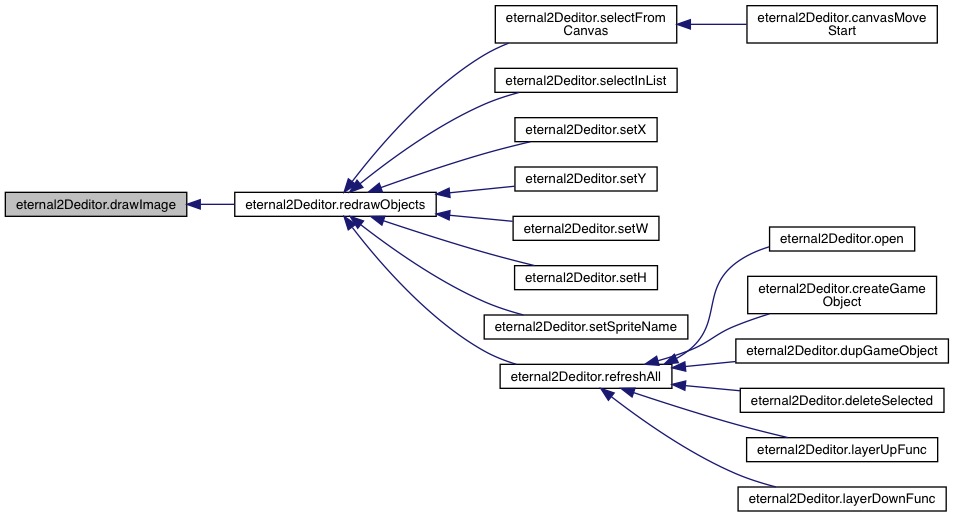
◆ dupGameObject()
| def eternal2Deditor.dupGameObject | ( | ) |
Duplicates the currently selected game object.

◆ getPath()
| def eternal2Deditor.getPath | ( | ) |
Gets the current OS path.
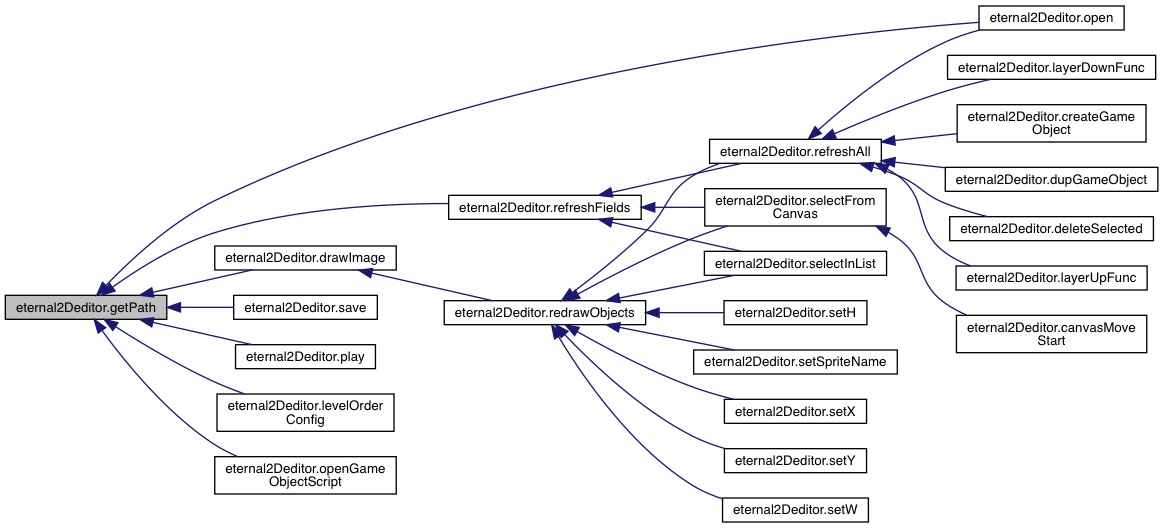
◆ layerDownFunc()
| def eternal2Deditor.layerDownFunc | ( | ) |
Sets the currently selected game object to be layered one layer down.

◆ layerUpFunc()
| def eternal2Deditor.layerUpFunc | ( | ) |
Sets the currently selected game object to be layered one layer up.

◆ levelOrderConfig()
| def eternal2Deditor.levelOrderConfig | ( | ) |
Gets the level order config file name.

◆ open()
| def eternal2Deditor.open | ( | ) |
Opens the current level file.

◆ openGameObjectScript()
| def eternal2Deditor.openGameObjectScript | ( | ) |
Opens the currently selected game object's script file.

◆ play()
| def eternal2Deditor.play | ( | ) |
Plays the current level file.

◆ redrawObjects()
| def eternal2Deditor.redrawObjects | ( | ) |
Redraws all game objects on the canvas.

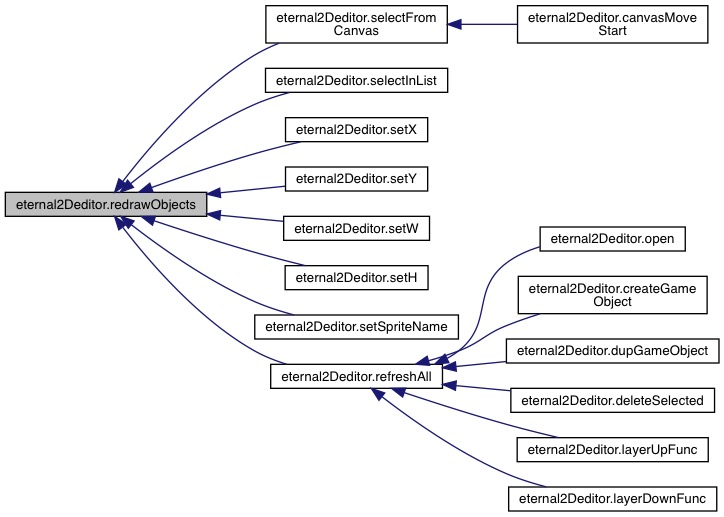
◆ refreshAll()
| def eternal2Deditor.refreshAll | ( | ) |
Refreshes everything.

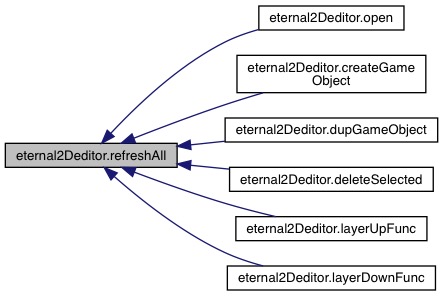
◆ refreshFields()
| def eternal2Deditor.refreshFields | ( | ) |
Refreshes all of the fields.

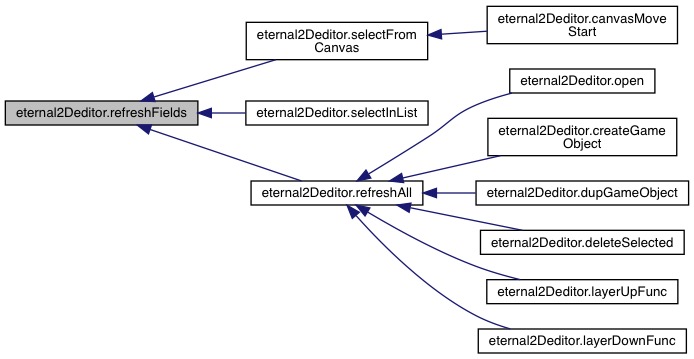
◆ refreshList()
| def eternal2Deditor.refreshList | ( | ) |
Refreshes the list of game objects.
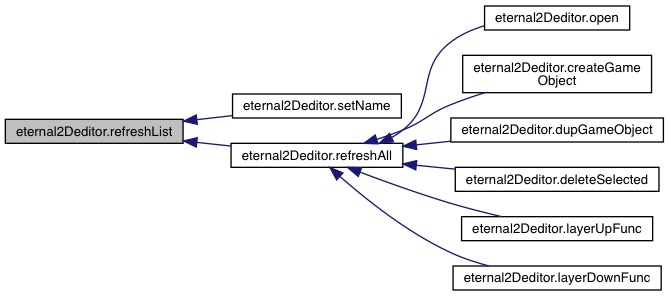
◆ save()
| def eternal2Deditor.save | ( | ) |
Saves the current level file.

◆ selectFromCanvas()
| def eternal2Deditor.selectFromCanvas | ( | event | ) |
Selects an object based on the cursor position.


◆ selectInList()
| def eternal2Deditor.selectInList | ( | event | ) |
Selects a game object from the list.

◆ setClassName()
| def eternal2Deditor.setClassName | ( | ) |
Sets the class name via class field input.
◆ setH()
| def eternal2Deditor.setH | ( | ) |
Sets the height via height field input.

◆ setName()
| def eternal2Deditor.setName | ( | ) |
Sets the name via name field input.

◆ setPermanentField()
| def eternal2Deditor.setPermanentField | ( | ) |
Sets the permanent field via permanent field input.
◆ setScriptName()
| def eternal2Deditor.setScriptName | ( | ) |
Sets the script name via script field input.
◆ setSpriteName()
| def eternal2Deditor.setSpriteName | ( | ) |
Sets the sprite name via sprite field input.

◆ setW()
| def eternal2Deditor.setW | ( | ) |
Sets the width via width field input.

◆ setX()
| def eternal2Deditor.setX | ( | ) |
Sets the x coordinate via x field input.

◆ setY()
| def eternal2Deditor.setY | ( | ) |
Sets the y coordinate via y field input.

Variable Documentation
◆ canvas
| eternal2Deditor.canvas = app.addCanvas(canvasTitle, 0, 0) |
Main canvas with images of GameObjects.
◆ canvasTitle
| string eternal2Deditor.canvasTitle = "Scene View" |
The title of the main canvas.
◆ classNameField
| string eternal2Deditor.classNameField = "Class Name" |
The label for the class name field.
◆ hField
| string eternal2Deditor.hField = "H" |
The label for the height field.
◆ layerDown
| string eternal2Deditor.layerDown = "Move Down" |
The label for the layer down name field.
◆ layerUp
| string eternal2Deditor.layerUp = "Move Up" |
The label for the layer up name field.
◆ moduleNameField
| string eternal2Deditor.moduleNameField = "Module Name" |
The label for the module name field.
◆ nameField
| string eternal2Deditor.nameField = "Name" |
The label for the namefield.
◆ permanentField
| string eternal2Deditor.permanentField = "Permanent" |
The label for the permanent field.
◆ spriteNameField
| string eternal2Deditor.spriteNameField = "Sprite Name" |
The label for the sprite name field.
◆ wField
| string eternal2Deditor.wField = "W" |
The label for the width field.
◆ xField
| string eternal2Deditor.xField = "X" |
The label for the x coordinate field.
◆ yField
| string eternal2Deditor.yField = "Y" |
The label for the y coordinate field.
 1.8.14
1.8.14